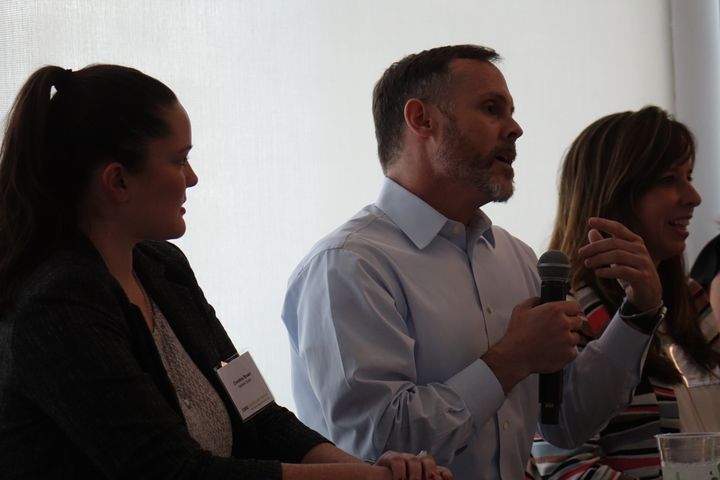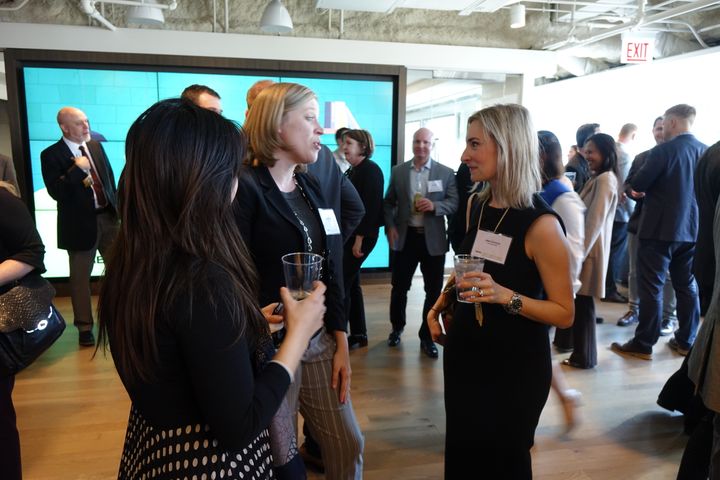These are the words that kicked off the CBRE Chicago Furniture Forum: Unraveling Furniture Frustrations on April 20 as a group of 130 contract interiors powerhouses gathered to discuss Chicago’s furniture buying process. The group was made up of key leadership from Chicago’s most influential A&D firms, CBRE project managers, nearly every Chicago-based contract furniture dealership, and representatives from every major manufacturer as well as dozens of ancillary manufacturers.

The goal of the forum was to drive conversation to open minds around what joint challenges we have, how we can come together collectively to improve this process for our clients, and to elevate the industry as a whole. Strategically selected individuals from three categories were brought together: dealer, manufacturer, and architecture and design (A&D) to openly discuss where each category was unknowingly causing wasted time, energy and money for the others. The panel discussion was the culmination of months of work by the eight panelists on stage at the forum as well as countless side-conversations with their peers. (You can read more about the process here and here.) But, can one conversation drive change? Initial survey results suggest so.
According to a post-event survey, more than 85 percent of attendees said they learned something new, and 87.3 percent said they are likely or very likely to try something different in their own furniture process after this discussion.
Many had ideas for ways to keep this grassroots movement going, and the teams at CBRE and Contract Consulting Group actively are pursuing those suggestions as part of a “phase 2” discussion in Chicago as well as other cities.

Panelists left to right Christina Brown (Eastlake Studio), Scott Delano (Wright Hereema), and Diana Brogan (The Ruder Group)
The panelists began by sharing details on the discovery process. Panelist Diana Brogen, ancillary furniture rep with The Ruder Group began, “The first session was the most enlightening of all the sessions. We started as a group of 20 and with each group process presentation learned of the different hot spots or pain points in the process. It was clear on day one that this task was larger than we all thought and we were not going to be able to solve every issue in the furniture process, but even one small improvement could constitute a win.”
Some notable discoveries included that designers don’t always have budget numbers when they issue the RFP, and although not a surprise that many are doing speculative work, this could be the first time these collective parties have sat together to discuss just how much the expanding ancillary package exponentially has grown the amount of speculative work required on the average project. Often there is no clear budget resulting in multiple options required for each line and multiple dealerships working on the bids. For the first time the collective team could visualize the massive amounts of wasted time and money that results from today’s process and approach.
Brogen, a seasoned veteran of this industry admitted, “I didn’t realize the time and money dealers spent on responding to a bid. I was shocked that it can cost $6,000 per bid with up to five bidders on a single project, each racking up multiple labor hours, when in most cases they are within 1-2 percent of each other in the end.”
Panelist Scott Delano, Design Director with Wright Hereema shared his thoughts from an A&D perspective, “The RFP process is something that we have all used for years as a way to get the best value for our clients, and yet as ancillary becomes a bigger piece of the puzzle, the current RFP process does not provide the value in a way that benefits the client. There is so much wasted time, effort and attention paid to this flawed (due to its heritage as a process based on the 80-90 percent workstation/private office world of decades ago) process. Everyone in the process is trying to do their best for the client, but by trying to pit groups against each other for a perception of competitive-pricing benefit, we are doing the client a disservice.”

Melissa Morris, Furniture Advisor with CBRE and key organizer of the event chats with guests at the pre-discussion happy hour.
Perhaps the most shocking discovery was that the main headaches - time wasters and money wasting points in the process, are shared by Dealers, A&D, Corporate Real Estate and Manufacturers alike. Panelist Russell Frees, Executive Vice President at Henricksen shared, “It was surprising that other groups have the same headaches as we do. The ancillary spec process is just so much more time consuming. Even though some requests are unrealistic, there was a common sense that said ‘we can’t say no or we will never see another one.’”
The group identified five major needs to improve the current process:
1. A clearly defined budget
2. An advisor who deeply understands furniture
3. A competitive bid
4. Ensuring furniture specs are coordinated with AV
5. Delivering a project on time and to budget
Suzanne Maynard, partner with Contract Consulting Group then shifted the discussion to describe new “efficiency opportunities,” - a set of ideas developed by the group. A visual map helped demonstrate the shift in recent years from the existing process to new ideas that could ease some of the current pain points. The efficiency opportunities map focused on getting a budget defined early, issuing a “mini-RFP” and pulling a dealer partner in much earlier in the process as a furniture advisor to the design firm. The team found that if the first few needs were met, the rest of the process flowed rather smoothly. But the team also acknowledged that even with the new “efficiency opportunities,” all issues were not 100 percent solved. The biggest challenge was pulling the dealer partner in early, while maintaining a competitive bid. These two things can, by nature, be seen as conflicting.

This was not designed to be a prescriptive process for every project, but rather a set of learnings developed by a cross-functional industry group with extensive feedback from their peers to help improve the process for each other and our clients. The guidelines and ideas discussed can be used by project members from any design firm, project management firm, dealer and manufacturer. A copy of the efficiency opportunity map presented can be downloaded here.
As Frees succinctly put it, “The healthcare crisis won’t be solved in a day, and neither will our industry's biggest challenges. But we do believe this will be a start to what we hope is a long, continuous, collective conversation that moves us in the right direction.” Panelist Jill Stewart, Business Development Director with Haworth closed the panel with this thought: “We all have much to gain if we can get around the one word that is the center of it all; Change."
About the author: Amanda Schneider, LEED AP is a trends researcher, blogger for the Huffington Post, and the founder of Contract Consulting Group , a research-led strategy firm serving the Contract Interiors Industry. Do you have something to add to this conversation? Want to take part? We invite you to e mail us at info@contractconsultinggroup.com. We would love to hear your ideas.
Disclosure: As the author of this post, it is required that I disclose that Contract Consulting Group is involved in the facilitation of CBRE’s Furniture Forum event and is in a paid relationship with CBRE.